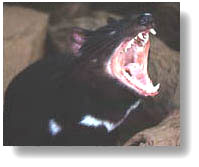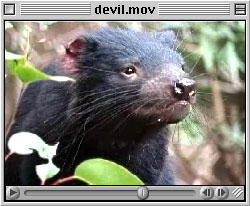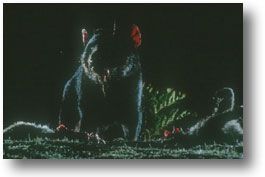|
|
|

|
|
|
Main Page
Sign the Petition Names |
 The Tasmanian devil (Sarcophilus harrisii) cannot be mistaken for any other marsupial. Its spine-chilling
screeches, black colour, and reputed bad-temper, led the early European
settlers to call it The Devil. Although only the size of a small dog, it
can sound and look incredibly fierce. The Tasmanian devil (Sarcophilus harrisii) cannot be mistaken for any other marsupial. Its spine-chilling
screeches, black colour, and reputed bad-temper, led the early European
settlers to call it The Devil. Although only the size of a small dog, it
can sound and look incredibly fierce.DescriptionThe world's largest surviving carnivorous marsupial, the devil has a thick-set, squat build, with a relatively large, broad head and short, thick tail. The fur is mostly or wholly black, but white markings often occur on the rump and chest. Body size also varies greatly, depending on the diet and habitat. Adult males are usually larger than adult females. Large males weigh up to 12 kg, and stand about 30 cm high at the shoulder.DistributionDevils once occurred on mainland Australia, with fossils having been found widely. Today, however the devil is only found in Tasmania. It is believed the devil became extinct on the mainland some 600 years ago - before European settlement of the continent. The dingo, which was brought into Australia by Aboriginal people, is believed to have ousted the devil from the mainland.Today, devils are particularly common in some north, east and central districts where some farming practices (e.g. rangeland sheep grazing) provide much carrion. Tasmanian devils can be seen in many rural and wilderness areas by slowly driving at night along secondary roads. Devils are readily seen at the Narawntapu (formerly Asbestos Range) National Park, Mt. William National Park, Cradle Mt. National Park, the Arthur River and highland lakes area. Look for them a few hours after sunset. Habitat Devils are widespread in Tasmania from
the coast to the mountains. They live in coastal heath, open dry
sclerophyll forest, and mixed sclerophyll-rainforest - in fact, almost
anywhere they can hide and find shelter by day, and find food at night. Devils are widespread in Tasmania from
the coast to the mountains. They live in coastal heath, open dry
sclerophyll forest, and mixed sclerophyll-rainforest - in fact, almost
anywhere they can hide and find shelter by day, and find food at night.
Click on the picture to view the movie. BreedingDevils usually mate in March, and the young are born in April. Gestation is 21 days. More young are born than can be accommodated in the mother's backward-opening pouch, which has 4 teats. Although 4 pouch young sometimes survive, the average number is 2 or 3. Each young, firmly attached to a teat, is carried in the pouch for about 4 months. After this time the young start venturing out of the pouch and are then left in a simple den - often a hollow log. Young are weaned at 5 or 6 months of age, and are thought to have left the mother and be living alone in the bush by late December. They probably start breeding at the end of their second year. Longevity is up to 7-8 years.DietThe devil is mainly a scavenger and feeds on whatever is available. Powerful jaws and teeth enable it to completely devour its prey - bones, fur and all. Wallabies, and various small mammals and birds, are eaten - either as carrion or prey. Reptiles, amphibians, insects and even sea squirts have been found in the stomachs of wild devils. Carcasses of sheep and cattle provide food in farming areas. Devils maintain bush and farm hygiene by cleaning up carcasses. This can help reduce the risk of blowfly strike to sheep by removing food for maggots.Devils are famous for their rowdy communal feeding at carcasses - the noise and displays being used to establish dominance amongst the pack. 
BehaviourThe devil is nocturnal (active after dark). During the day it usually hides in a den, or dense bush. It roams considerable distances - up to 16 km - along well-defined trails in search of food. It usually ambles slowly with a characteristic gait but can gallop quickly with both hind feet together. Young devils are more agile however and can climb trees. Although not territorial, devils have a home range.The famous gape or yawn of the devil that looks so threatening, can be misleading. This display is performed more from fear and uncertainty than from aggression. Devils produce a strong odour when under stress, but when calm and relaxed they are not smelly. The devil makes a variety of fierce noises, from harsh coughs and snarls to high pitched screeches. A sharp sneeze is used as a challenge to other devils, and frequently comes before a fight. Many of these spectacular behaviours are bluff and part of a ritual to minimise harmful fighting when feeding communally at a large carcass.
|